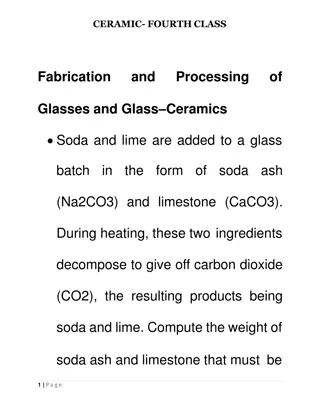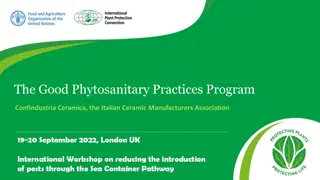Understanding Raw Materials in Ceramic Production
Raw materials play a crucial role in ceramic production, with three main groups identified - plastic materials like clay, non-plastic or leading mixtures such as silica, and fluxes/mineralizers like feldspar. These materials undergo various transformations during the manufacturing process, contributing to the final properties of the ceramics. Feldspar, found in crystalline rocks like granite and gneiss, is a key component that undergoes decomposition when exposed to atmospheric conditions. Other important ingredients include aluminum silicate in the form of kaolinite, which is a prominent constituent of kaolin or white china clay. Understanding the properties and interactions of these raw materials is essential for producing high-quality ceramics.
Download Presentation

Please find below an Image/Link to download the presentation.
The content on the website is provided AS IS for your information and personal use only. It may not be sold, licensed, or shared on other websites without obtaining consent from the author. Download presentation by click this link. If you encounter any issues during the download, it is possible that the publisher has removed the file from their server.
E N D
Presentation Transcript
Raw material Three groups
i) Plastic material- clay ii) Non-plastic or leading mixtures- silica iii) Fluxes/ mineralizers- promotes formation of liquid phase- feldspar Raw material is clay + feldspar + sand
Feldspar is present in crystalline rocks (as granite/gneiss) Granite- unstratified, granular rock Gneiss laminated rock (arranged in layers) both has quartz, feldspar, mica * Feldspar attacked by atmospheric carbonic acid (CO2+ H2O) and undergo decomposition with formation of alkali carbonate, aluminium silicate and sand
Aluminum silicate in hydrate form is Kaolinite and main constituent of kaolin/white china clay
Raw material Kaolinite feldspar Sand/flint Al2O3.2SiO2.2H2O K2O.Al2O3.6SiO2 SiO2 plastic Non-plastic Non-plastic refractory Easily fusible refractory 1785oC 1150oC 1710oC Much shrinkage fuses No shrinkage
Clay is important in production of porcelain , stone and earthen ware- since it forms with water a plastic mass which becomes hard and stone like when heated to high temperature Clays are plastic and mould able when sufficiently finely pulverized and wet, rigid when dry and vitreous when fired at a higher temperature
Three types or feldspar i) Potash feldspar-K2O.Al2O3.6SiO2 (orthoclase/microline) ii) Soda/albite Na2O.Al2O3.6SiO2 iii)lime- CaO.Al2O3.6SiO2
Other ingredients Used as a fluxing agent(which lower temperature) and special refractory material
Fluxing agents Borax Na2B4O710H2O * iron oxides Boric acid Barium materials Soda ash Sodium nitrate Calcined bones Cryolite Lead oxides *lithium minerals *antimony oxides fluorspar
Special refractory materials Alumina Zirconia Titania Thoria Chromite Lime Lime stone Dolomite mullite *magnesite *carborundum * aluminium silicate
manufacture For both glazed and unglazed Unglazed manufactured- then apply glaze either before of after firing Steps
1) Grinding of raw materials * raw materials other than clay are ground finely- mix with clay to get uniform mixture Done by- weathering, calcination, mechanical crushing machines Subsequently reduced to fine size by pan mills, edge roller mills, ball/pebble mills
2) Mixing or preparation of bodies Mixed in definite proportion to have specific property Mixed with required amount of clay and water in a tank called as blunger Creamy layer passes through a sieve to separate coarse particles Pass through an electromagnetic set to remove iron bearing particles
Mixing done by following methods i) Clay is manipulated in a plastic state, either soft or stiff ii) Clay mixed in dry state and add required water iii) Dissolve clay in water, mix clay with dry or wet pulverised non-plastic material and remove water in filter press
3) Body preparation using clay in plastic state Since plastic clay is very sticky mixing is not very intimate Thorough mixing- if plastic materials are dried and then crushed Mixing of various materials is done in alsing cylinders, dust mills, rotating propeller machines
4) Body preparation using clay slip i) filtering * mixed mass called slip is pumped into filter presses to remove excess water Filter press is used for turning the water slip into a plastic body The solid part of slip- is a plastic body called as filter cake Rotary vacuum filters can also be used
ii) Kneading * filter cake from filters are put into pug mill, which is used to mix the material in plastic or semi plastic state Vertical or horizontal plug mills are used Throwing is the process by which different shapes are given to clay mass- like potters wheel
Articles other than round shape are formed in plaster moulds For articles of irregular form plaster or plaster of Paris moulds are used- plaster of paris absorbs water from clay and does not adhere the soft clay, so clay can be easily removed from the body.
iii) Jollying mechanical process of making a large number of similar articles through moulds economically iv) Slit casting *Process of giving shapes to clay wares from clay liquid- used for articles of complex shape, refractory, cheap and reusable moulds, dinner ware, plumbing ware
V) pressing process for making plastic, semi-plastic and powder bodies Plastic- tiles, roofings, drain pipes Powder- wall/floor tiles
Vi) extrusion forcing plastic paste through a die or mouth piece of required shape. vii) Turning dune in lathes- before turning a ceramic body, body should be dried to reasonable hard state Medium /large particles- body can be in semi hard state Small articles- (spark plug) turned in hard state
5) Drying Articles dried well before firing Imperfect drying causes craking of articles during firing Speed of drying depends on * shape of article * temperature of surrounding air * rate of air circulation * humidity content of surrounding air
Dried in intermediate driers(lifts, hot floor), semi continuous dryer(dobbins), continuous dryer( tunnel dryers and mangles) Nowadays drying by- IR/high frequency
6) Firing Clay materials acquire durability /other qualities when heated at high temperature. Finally dried articles are known as - blanks Glaze is put on blanks before firing In most cases blanks are fired to produce bisques/biscuits- then put glaze on cold biscuits and then fire
During firing the following happens i) dehydration- rate maximum at 500oC ii) Oxidation- between 300-900oC- sulphur and iron compounds are oxidized iii) Decomposition- of carbonates of Ca/Mg iv) Vitrification or melting- to cover up and bond the unmelted mass or particles on cooling- volume reduces 950-1050oC
V) reduction- colour dilution of processed articles- cut air supply to kiln vi) annealing- slow cooling to fired clay vii) decoration
7) Glazing Important in white/ table wares Glaze- a thin coating of glass that is melted on to the surface of the more or less porous ceramic material. Glaze is a fine powder consisting of a mixture of glass forming material of proper composition-like lead silicates, boro silicates
Glaze contains feldspar, silica, china clay, soda, potash, fluorspar, borax Glazing done by- dripping, spraying, pouring, brushing of glaze material on dry blanks of clay material
Glazing done for Decorative effect Improve appearance of article Improve durability of ceramic material To provide smooth and glossy surface To protect article from environmental and atmospheric effects To make surface impervious to liquids.























